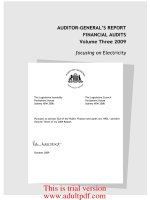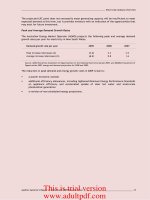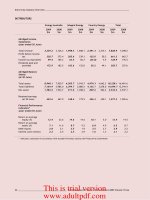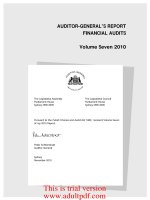New South Wales Auditor-General’s Report Financial Audit Volume Seven 2011 Focusing on Law, Order and Emergency Services_part4 docx
Bạn đang xem bản rút gọn của tài liệu. Xem và tải ngay bản đầy đủ của tài liệu tại đây (197.17 KB, 10 trang )
29
NSW Auditor-General's Report
Volume Seven 2011
DEPARTMENT OF ATTORNEY
GENERAL AND JUSTICE
Corrective Services NSW advise that the most recent financial year end coincided with the
ongoing amalgamation of the former Attorney General’s and Corrective Services
Departments, as well as the transfer of the functions of the former Juvenile Justice division
and the Guardianship Tribunal. The revaluation of land and property assets across the entire
Department was also completed within a very short timeframe.
Corrective Service NSW further advise that the introduction of an enterprise assets
management policy, and the remediation of the Business Integrated Management System due
for completion in 2012, will ensure all these concerns are resolved by 30 June 2013.
Performance Information
Attorney General’s Division
Corrective Services NSW
Last year, I commented on Corrective Services NSW’s working capital ratio. This has
increased from 15.7 per cent to 31.8 per cent, improving its ability to pay its creditors on time.
The improvement reflects additional funding it received towards the end of the financial year.
Offender and Imprisonment Rates
The number of people and the length of offender sentences managed by Corrective Services
NSW result from the activities of the NSW Police Force and sentencing authorities. Therefore,
they are not performance measures of Corrective Services NSW, but drive some of its
performance measures.
Year ended 30 June
2010
2009
2008
NSW
National
NSW
National
NSW
National
Rate per 100,000 adult population
Imprisonment
186
169
185
166
180
163
Community corrections
318
336
335
342
339
338
Rate for Indigenous per 100,000 adult indigenous population
Imprisonment
2,455
2,325
2,391
2,212
2,351
2,157
Community corrections
3,358
3,345
3,532
3,350
3,761
3,288
Source: Productivity Commission’s Report on Government Services 2011 (unaudited).
The table shows the proportion of the general adult population imprisoned in 2010 remained
relatively stable, while the proportion of the indigenous adult population imprisoned increased
by 2.7 per cent.
In the case of community corrections, the proportion of the general adult population subject to
community correction orders decreased by 5.1 per cent, and 4.9 per cent for the indigenous
adult population.
Of the total prison population at 30 June 2010, 20.9 per cent of male and 26.3 per cent of
female offenders were indigenous. Corrective Services NSW continues to implement
programs to reduce the high rate of indigenous offenses and imprisonment. These include:
the Rekindling the Spirit program (Lismore and Tabulam)
the Walking Together Project (Newtown/Redfern)
the Balund - a community based program at Tabulam
the Yindyama La Family Violence Project (Dubbo).
This is trial version
www.adultpdf.com
30
NSW Auditor-General's Report
Volume Seven 2011
DEPARTMENT OF ATTORNEY
GENERAL AND JUSTICE
In May 2011, I conducted a performance audit on the ‘Two Ways Together – NSW Aboriginal
Affairs Plan’ (the Plan) to consider how well the Plan has worked to improve outcomes for
Aboriginal people in NSW. The overall objectives of the Plan were to:
develop committed partnerships between Aboriginal people and the NSW Government,
and
improve the social, economic, cultural and emotional wellbeing of Aboriginal people in
New South Wales.
The report concluded that to date the Plan has not delivered the intended overall outcomes for
Aboriginal people, although stronger partnerships between the government and Aboriginal
people are now beginning to emerge.
The full report is available on the Audit Office’s website at
www.audit.nsw.gov.au/ArticleDocuments/143/213_Two_Way_Together_Aboriginal_Affairs.pdf
.aspx?Embed=Y.
Safety and Containment
The table below shows that from 2009 to 2010 prisoner on prisoner assaults increased by
five per cent, serious assaults by prisoners on prisoners decreased by 42 per cent, assaults
by prisoners on prison staff remained relatively stable and there were no serious assaults by
prisoners on prison staff. Prisoner escapes reduced by 81 per cent between 2009 and 2010.
Year ended 30 June
Rate per 100 offenders
2010
2009
2008
NSW
National
NSW
National
NSW
National
Type of Assault
Prisoner on prisoner*
Serious assault
0.15
0.53
0.26
0.68
0.31
0.48
Assault
13.43
9.14
12.83
8.66
13.07
8.52
Prisoner on officer*
Serious assault
0.03
0.03
0.02
Assault
0.56
0.64
0.59
0.53
0.92
0.63
Apparent Unnatural Death
0.06
0.05
0.04
0.04
0.04
0.03
Escapes/Absconds Rates
Open perimeter
0.06
0.3
0.31
0.57
0.16
0.51
Secure perimeter**
0.01
0.02
0.06
0.02
0.02
0.09
Source: Productivity Commission’s Report on Government Services 2011 (unaudited).
* The Productivity Commission acknowledges that data on assaults are not directly comparable across all States.
‘Serious assaults’ refer to acts of physical violence resulting in actual bodily harm involving hospitalisation,
including sexual assault. Assaults refer to violence resulting in physical injury but not involving hospitalisation.
** Information not available for every jurisdiction.
This is trial version
www.adultpdf.com
31
NSW Auditor-General's Report
Volume Seven 2011
DEPARTMENT OF ATTORNEY
GENERAL AND JUSTICE
Prisoner Costs
Year ended 30 June
Cost per prisoner per day
2010
2009
2008
NSW
$
National
$
NSW
$
National
$
NSW
$
National
$
Open prisons* (including periodic
detention)
175
187
187
191
188
189
Secure prisons*
211
214
217
218
225
214
All prisons
198
207
206
210
211
207
Source: Productivity Commission’s Report on Government Services 2011, 2010 and 2009 (unaudited).
The figures include ongoing expenditure in the delivery of correctives services such as salaries and other operating
expenses. The costs are adjusted to eliminate jurisdictional differences.
* Information not available for the Northern Territory.
The cost per prisoner per day for all prisons reduced to $198 in 2010. Corrective Services
NSW advises this was because employee related costs have decreased and some custody
resources moved to community programs.
Offenders in custody compared to capacity of correctional centres
The average daily number of offenders in custody decreased from 10,258 in 2009–10
to 9,916 in 2010–11, or 3.3 per cent. At the same time, the capacity of correctional centres
increased from 11,011 to 11,269 beds, or 2.3 per cent. Corrective Services NSW advises the
new Intensive Correction Order (ICO) which started in October 2010 has contributed to this
decrease. An ICO is an order of imprisonment for not more than two years made by a court,
which directs the sentence to be served by way of intensive correction in the community. An
ICO is served in the community under the strict supervision of Corrective Services NSW,
rather than in full-time custody in a correctional centre.
The occupancy rate at the end of June 2011 was 88 per cent (93.2 per cent). The table below
shows the number of offenders at each level of security facilities.
At 30 June
Offenders in
custody
Capacity
Offenders in
custody
Capacity
2011*
2011*
2010**
2010**
Correctional Centre
Maximum security facilities
3,799
4,380
3,673
4,001
Medium security facilities
2,548
2,818
2,919
3,088
Minimum security facilities
3,569
4,071
3,666
3,922
Total
9,916
11,269
10,258
11,011
Source: Corrective Services NSW (unaudited).
* at midnight 26 June 2011.
** at midnight 27 June 2010.
Overcapacity continued to increase after year end, with the inmate population decreasing by a
further 69 inmates to 9,847 at 28 August 2011. In response to the overcapacity, on
6 September 2011, Corrective Services NSW announced that the Parramatta, Kirkconnell and
Berrima Correctional Centres would close. These centres have a combined capacity of 905
inmates, and held 430 inmates at the date of the announcement. All three correctional centres
closed during October 2011.
The inmates have been relocated, and staff offered voluntary redundancy or redeployment.
Corrective Services NSW estimates this will result in savings of $26 million per annum.
This is trial version
www.adultpdf.com
32
NSW Auditor-General's Report
Volume Seven 2011
DEPARTMENT OF ATTORNEY
GENERAL AND JUSTICE
Juvenile Justice
The Juvenile Justice division of the Department deals with young offenders who have
committed, or alleged to have committed offences and are between the ages 10 and 18. It
delivers its services under three service groups (programs), namely Youth Justice
Conferencing, Community Based Services and Custodial Services.
Costs
The table below shows the average daily cost for supervising and caring for young offenders
over the past four years.
Year ended 30 June
2011**
$
2010
$
2009*
$
2008*
$
Average daily cost per juvenile in custody
652
589
543
541
Average daily cost per juvenile in
community based services
17
13
15
16
Average daily cost per juvenile in Youth
Justice Conferencing
7
6
7
10
Source: Department of Attorney General and Justice (unaudited).
* Responsibility of the former Department of Juvenile Justice.
** Responsibility of the Department of Family and Community Services up to 31 March 2011, and the Department
of Attorney General and Justice thereafter.
Juvenile Justice advises:
the average daily cost per juvenile in custody increased by 10.7 per cent due to the costs
of opening two new units at the Acmena and Reiby Centres, coupled with a reduction in
the average number of juveniles in custody over the year
the increase in the average daily cost per juvenile in community-based services was due
to the additional costs of introducing Graffiti Orders, whilst the average number of young
people serviced by Juvenile Justice reduced.
Capacity in Juvenile Justice Centres
The following table shows the number of offenders in custody and the number of available
beds at each Juvenile Justice centre. Whilst total capacity increased by 5.3 per cent, the total
number of young offenders in custody decreased by 8.6 per cent.
At 30 June
Juvenile Justice Centre
Offenders in
custody
2011*
Capacity
2011*
Offenders in
custody
2010*
Capacity
2010*
Acmena
34
45
27
30
Frank Baxter
106
120
119
120
Broken Hill Shelter
8
8
Cobham
62
85
70
85
Emu Plains
31
40
36
40
Juniperina
29
46
31
46
Orana
37
45
41
45
Reiby
52
67
49
57
Riverina
36
45
46
45
Bronte Adolescent Mental Health Unit**
4
Na
9
na
Total
391
501
428
476
Source: Department of Attorney General and Justice (unaudited).
* Responsibility of the Department of Family and Community Services up to 31 March 2011, and the Department
of Attorney General and Justice thereafter.
** The Bronte Adolescent Mental Health Unit facility is administered by Justice Health. The facility’s capacity is not
administered by Juvenile Justice and is therefore not applicable.
This is trial version
www.adultpdf.com
33
NSW Auditor-General's Report
Volume Seven 2011
DEPARTMENT OF ATTORNEY
GENERAL AND JUSTICE
In October 2010, a new 15 bed unit opened at the Acmena Centre and an additional 10 beds
were added at the Reiby Centre. Upgrades to the Riverina Juvenile Justice Centre will result
in a new 15 bed unit being built in 2013.
Other Information
Major Projects
JusticeLink project costs and implementation
JusticeLink has been a long term information technology project that has suffered delays and
required increases in its budget. All components of the project were implemented during
2009–10.
The Department advises the major works to the JusticeLink project were completed during
2009-10 at a total cost of $48.2 million. Enhancements to the original project continued to be
made during 2010-11 at a total cost to date of $11.8 million. These included changes in
business processes, client services and best practice.
The table below shows a summary of the projected completion dates and costs of the project.
I have combined the costs and budgets of the Courtlink project from 2001 and the JusticeLink
project from 2006 as they are related projects.
Year ended 30 June
JusticeLink major works budget forecasts
2001
2005
2006
2007
2008
2009
2010
2011
Expected Completion
2006
2007
2007
2008
2009
2010
2010
Completed
Capital cost of project to date
($m)
ns
29
34
ns
44
46
48
48
Total Expected Cost ($m)
30
42
45
48
48
48
48
48
Source: 2005 to 2010 Auditor-General's Reports to Parliament and information provided by the Department for 2011 (unaudited).
ns not stated.
Year ended 30 June
Enhancements (from minor works appropriation)
2008
2009
2010
2011
Cost of original project to date
($m)
3
6
9
12
Source: Information provided by the Department for 2011 (unaudited).
Last year, I reported on the inability of JusticeLink to automatically refer debts to the State
Debt Recovery Office due to unresolved interface issues. The outstanding debts of
$31.4 million at that time have reduced to $10.7 million as at 30 June 2011, mainly due to
enhancements to the JusticeLink system.
Last year, I also reported the Department’s bank reconciliations were affected by changed
procedures for JusticeLink. A significant number of ledger and bank entries could not be
matched in a timely manner. The Department has made several changes to JusticeLink and
to business processes to resolve all outstanding issues during 2010-11.
This is trial version
www.adultpdf.com
34
NSW Auditor-General's Report
Volume Seven 2011
DEPARTMENT OF ATTORNEY
GENERAL AND JUSTICE
The Department, along with key stakeholders, is auditing the data received from the higher
courts. These audits are performed to ensure the statistics for offences compiled from the
JusticeLink system are accurate. Errors noted by the audit can be seen in the table below.
Year
2009-10
2008-09
Error Types
Number of errors
noted
Number of cases
checked
Number of errors
noted
Number of cases
checked
Critical
839
31,857
1,525
29,124
Non Critical
1,411
31,147
1,605
28,871
Total
2,250
63,005
3,130
57,995
Source: Information provided by the Department (unaudited).
There is a notable decrease in the number of both critical and non-critical errors noted during
the reviews conducted in 2009–10 compared to the previous year. This was as a result of the
Department implementing quality control mechanisms to improve the data quality in the
JusticeLink system.
Other IT Projects
LifeLink
The LifeLink project commenced in 2002–03 to replace the Registry of Births, Deaths and
Marriage’s paper-based LifeData system. In November 2009, the Department terminated the
contract with the project provider due to a substantial breach of contract, and a new contract
was entered into with another provider in September 2010. A total of $3.5 million was written
off during 2010–11, as the work performed up to the date of termination could not be used by
the new provider.
In 2010–11, the Department successfully sued the terminated contractor and obtained a
judgement of $2.7 million. Payment was received on 15 July 2011.
An audit of the status of the project was completed in September 2011. The project is now
expected to be completed by August 2012.
The table below provides details of the expected costs of the project. The Department has
assessed that the benefits from this project will significantly exceed the costs.
Phase 2 of the project
Ongoing maintenance
Year
2010-11
2011-12
2012-13
2013-14
2014-15
2015-16
Total Cost ($m)
7.8
3.7
0.5
0.5
0.5
0.5
Source: Registry of Births Deaths and Marriages LifeLink Program August 2010 Business Case (unaudited).
Joined Up Justice
This project will enable New South Wales courts to expand and improve the electronic
exchange of information with other Justice agencies. The Department advised the total
expected cost of the project remains at $9.9 million with $2.9 million ($3.0 million) spent
during 2010–11. The project is expected to be completed in August 2012 and it is tracking on
target without any delays. It is expected that $300,000 will be rolled over to 2012–13 to cover
the costs of the final stage of the project.
Legal eServices
This two year project will reduce waiting times in courts and provide secure internet access to
information only available in courts. The Department advises the total expected cost of the
project remains at $10.0 million. The Department has spent $5.1 million ($3.1 million) in
2010–11. The major implementation is expected to occur in June 2012, with $150,000 to be
rolled over to 2012-13 to cover the final cost of the project. The first online process from the
project was launched in April 2011.
This is trial version
www.adultpdf.com
35
NSW Auditor-General's Report
Volume Seven 2011
DEPARTMENT OF ATTORNEY
GENERAL AND JUSTICE
Major Capital Projects and Correctional Centre Occupancy Rates
Recommendation
The Department continue to monitor the rate of its correctional centres occupancy, and
assess whether further rationalisation is required.
In 2010–11, Corrective Services NSW:
continued work on the 250-bed expansion of Cessnock Correctional Centre. This project
commenced in June 2005 and completion is expected in 2012. The budgeted cost is
$98.6 million and at 30 June 2011 the actual cost was $66.7 million
commissioned the new 600-bed multi-classification facility on the South Coast in
December 2010. The project commenced in June 2005 with a budgeted cost of
$155 million. The actual cost at 30 June 2011 was $147.4 million.
Recommendation
While completion of these projects adds to current overcapacity, the projects commenced
when prisoner numbers were increasing. The Department will need to continue to monitor the
prison population to ensure the available capacity is appropriate.
Human Resources
Excessive Annual Leave
Last year, I recommended the Department review the effectiveness of its policies for
managing excessive annual leave balances.
Corrective Services had 1,796 employees (2,326 employees) with more than 40 days of
accrued annual leave at 30 June 2011. The highest employee leave balance at 30 June 2011
was 153 days.
While the situation improved in 2010–11, managing excessive annual leave remains a
challenge for the Department.
Overtime
Recommendation
Corrective Services NSW should continue its efforts to reduce overtime and continuously
reassess the effectiveness of its policies and management of overtime.
Corrective Services NSW incurred overtime in 2010–11 of $18.8 million ($32.8 million),
representing 2.6 per cent (4.6 per cent) of total employee related expenses. Some initiatives
implemented under the ‘Way Forward’ program, such as the use of casual officers instead of
offering overtime, have contributed to the decrease.
While there has been an overall reduction in overtime, 3,712 (4,221) employees received
overtime payments, with 26 (114) of these receiving overtime payments equal to or exceeding
50 per cent of their base pay.
Employment of Contractors
Recommendation
Last year, I recommended the Attorney General’s Division create and maintain a single record
of all contractors engaged by the Division.
The Division still does not maintain a central registry for all contractors but agrees with the
recommendation above. It has commenced this process through the completion of an initial
register. The issue of fully installing and maintaining a contractor register is currently under
review by the Department centrally, with a view to leveraging upon established best practices
and processes across different divisions of the Department.
Corrective Services NSW advises it maintained a central registry for contractors engaged
during the year and it is reviewed regularly.
This is trial version
www.adultpdf.com
36
NSW Auditor-General's Report
Volume Seven 2011
DEPARTMENT OF ATTORNEY
GENERAL AND JUSTICE
While the use of contractors has its benefits, particularly on projects, extensive reliance on
this employment source may result in higher employment costs and less ownership and
commitment to organisational goals and objectives.
Financial Information
Abridged Statement of Comprehensive Income
Year ended 30 June
2011
$’000
2010
$’000
Employee related expenses
1,260,478
1,188,426
Compensation to victims of crime
63,385
62,650
Other expenses
660,882
577,070
Operating Expenses
1,984,745
1,828,146
Operating Revenue
315,240
295,375
Other losses
11,950
6,301
Net Cost of Services
1,681,455
1,539,072
Government contributions
1,751,627
1,542,348
Surplus
70,172
3,276
Other Comprehensive Income
Increase in revaluation reserve
362,408
48,399
Decrease in net assets through equity transfer
(5,745)
Superannuation actuarial loss
(165)
(10,030)
Total Other Comprehensive Income
356,498
38,369
Total Comprehensive Income
426,670
41,645
Employee related expenses increased due to pay increases and the transfer of Juvenile
Justice from 1 April 2011 to the Department. Refer to the Law and Order Overview for
Administrative Restructure comment.
Contributing to the increase in other expenses was an additional $22.8 million given to Law
Courts Limited for significant upgrades and maintenance of the Supreme Courts, and
additional grants of $11.2 million to Juvenile Justice and NSW Trustee and Guardian.
Operating revenue increased due to a rise in victims compensation levies of $3.7 million,
other grants and contributions of $9.5 million, and filing fees of $7.5 million.
Land and buildings and other assets were revalued at 30 June 2011, resulting in the increase
in asset values.
Abridged Statement of Financial Position
At 30 June
2011
$’000
2010
$’000
Current assets
175,305
149,278
Non-current assets
3,849,757
3,175,092
Total Assets
4,025,062
3,324,370
Current liabilities
323,384
343,951
Non-current liabilities
149,090
151,318
Total Liabilities
472,474
495,269
Net Assets
3,552,588
2,829,101
Current Assets increased primarily because of an increase in cash due to better collection
processes and increased activities during the year.
This is trial version
www.adultpdf.com
37
NSW Auditor-General's Report
Volume Seven 2011
DEPARTMENT OF ATTORNEY
GENERAL AND JUSTICE
Non-current assets increased due to the transfer of $289 million of assets to the Department
through the Administrative Restructure; increases in asset values of $362 million; and
$158 million of construction works for new correctional centres.
Abridged Service Group Information
The net cost of services on a service group basis is detailed below:
Year end 30 June
Net Cost of Services
Net Assets
2011
Budget
$’000
2011
Actual
$’000
2010
Actual
$’000
2011
Actual
$’000
2010
Actual
$’000
Legal, Policy and Regulatory
Services
40,313
37,099
31,651
9,600
19,815
Court Services
309,847
317,147
284,020
1,289,612
1,059,745
Court Support Services
85,778
86,219
85,154
84,652
52,653
Crime Prevention and
Community Services
104,432
103,192
91,968
9,067
14,055
Registry of Births, Deaths and
Marriages
(9,652)
(10,070)
(5,745)
17,118
6,804
Crown Solicitors Office
34,578
46,861
42,212
15,292
12,206
Business and Personnel
Services
(1,394)
(6,185)
(117)
Custody Management
685,835
761,148
733,496
1,616,502
1,593,957
Supervision of Offenders in the
Community
126,575
154,871
144,701
151,269
45,033
Offenders Program
123,935
135,328
137,800
67,546
2,896
Non-Custodial Services*
17,151
20,193
(1,326)
Custodial Services*
28,638
33,109
282,822
Not Attributable
(2,248)
10,434
22,054
Total
1,547,430
1,681,455
1,539,072
3,552,588
2,829,101
* Service Groups from Juvenile Justice transferred to the Department on 1 April 2011.
The overall increase in net cost of services across all service groups is primarily attributed to a
four per cent increase in salary costs.
Court Service’s net cost of services increased by $33.1 million over the prior year primarily
due to a $22.8 million contribution to a major refurbishment of the Supreme Courts NSW.
Custody Management’s net cost of services increased by $27.6 million due to an increase in
correctional centre management costs of $11.7 million. The Department hired an additional
110 staff as a result of the new South Coast Correctional Centre which opened in
November 2010.
The Crown Solicitor’s Office incurred additional costs in employee related expenses and legal
disbursements due to an increase in the core legal work in the current year, including
increased work in highly complex and sensitive children's matters and increased number of
matters referred to the office from the Coroners Court. The office received a one-off
supplementation of $14.8 million to meet the increase in core expenditure.
Supervision of Offenders in the Community’s net cost of services exceeded budget by
$28.3 million. This was mainly due to increased activity in community compliance and the
community offender support programs. These programs were introduced in October 2010.
This is trial version
www.adultpdf.com
38
NSW Auditor-General's Report
Volume Seven 2011
DEPARTMENT OF ATTORNEY
GENERAL AND JUSTICE
Department Activities
The Department of Attorney General and Justice delivers legal, court and custodial and
community supervision services to the people of New South Wales.
The Department divisions are the Attorney General’s Division, Corrective Services NSW and
Juvenile Justice NSW.
The Attorney General’s Division manages and supports the State’s court registries and legal
jurisdictions, implements crime prevention programs and supports victims of crime. It also
provides research data and legal and policy advice to the New South Wales Government and
the community.
Corrective Services NSW provides custodial and community based correctional services,
conducts programs and services that reduce the risk of re-offending, prepares offender
reports to assist sentencing and releasing authorities, and supplies prisoner security services
at a number of courts.
Juvenile Justice NSW supervises and cares for young offenders in the community and in
detention centres. It provides youth justice conferences for young offenders referred by police
or the courts.
Department services also include those provided by the Registry of Births, Deaths and
Marriages, the Guardianship Tribunal and the Crown Solicitor’s Office.
The Department supports the Attorney General as the Crown’s First Law Officer.
For further information on the Department of Attorney General and Justice, refer to
www.lawlink.nsw.gov.au.
This is trial version
www.adultpdf.com









